At the start of KKL-JNF's 80th year, Moshe Rivlin, with the characteristic "hassidic zeal" once attributed to him by a journalist, noted that the Fund's work was far from over. Redemption, he delivered a reminder, meant not only land purchase, but mainly land reclamation. "There is no redemption for the soil except for its redemption from devastation." As the Fund celebrated its 80th year, he noted, it had been, and remained, fired by a vision: "…the vision of restoring the Jewish People to their historical homeland to strike roots in its soil. The vision of national land ownership by the entire Jewish People. The vision of the Jewish farmer whose toil wrests soil from desolation. The vision of partnership with the Jewish People in building up the land…"
Meanwhile, the realization of this vision during the Fund's first 80 years could be summed up in round numbers: a million dunams of soil reclaimed by KKL-JNF since statehood and another million planted with new forests. As impressive as the figures were after eight decades of restoring the land to the Jewish People and rooting the People in the land by enormous endeavor – the work, one still could say, had only just begun.
The new decade opened with bulldozers working full swing in the north, preparing the new Galilee outposts (mitzpim) started in the previous decade.
At the same time, trucks and heavy equipment were on the move in the Negev, with headlines reporting on a vision for 50 new communities there. The first step in what was known as the "southern project" saw land reclaimed and settled in the Besor Peace Salient (Pit'hat Shalom) following the withdrawal from Sinai in 1982. The new communities of Yated, Yesodot HaDarom (Sde Avraham), Pri-Gan, Talmei Yosef, Holit, Sufa, and Dekel were populated mostly by evacuees from Sinai.
Simultaneously, KKL-JNF's land experts and legal department stepped up the pace of land purchasing in Lower and Upper Galilee as part of the drive to increase the Jewish population there. As the 1980s opened, KKL-JNF certainly had its hands full in both the south and north.
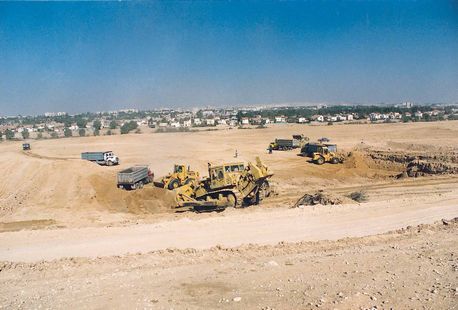
Reclaiming land for immigrant neighborhoods in Beersheba, 1990. KKL-JNF Photo Archive
Afforestation in the '80s, KKL-JNF's ninth decade, was characterized by diversification of tree types and areas planted. One quarter of all plantings during these years took place in the south, around Beersheba and even in the southern Arava on the way to Eilat.
No one had believed that these desert areas could ever be green, but by the end of this decade Weitz's dream was visibly coming true with the addition of another 180 thousand dunams of trees to the tough heart of southern soil. In the wake of the Sinai pullback, KKL-JNF also quickly planted trees around IDF bases that sprang up in the Negev, creating shade and green islands in the yellow desert sea. The woodland trees were planted in conjunction with the military to make their new desert home not only pleasanter and cooler, but also, as one base commander said, "more humane," curbing the clouds of dust raised by the tanks.
Other boulevards of trees were planted in the Negev to break the strong desert winds, which caused soil erosion and created a sense of transience and wander. The Negev trees soon became a symbol of stability, proclaiming loud and clear: this is where the desert stops. Here the sands no longer drift, the foothold is permanent. Here Zionism has triumphed.
During those years, when the desert donned additional green cover just as Herzl had dreamed, there was growing awareness of the need for conservation alongside development. KKL-JNF continued to look ahead, to the needs of the state, but it did so with a healthy respect for nature; it sought to work within nature, not against it. Its forestry and other field workers defined their dreams as "green." They never had any intention of making the desert disappear or detracting from its majesty; they merely wished to "roll it back."
A new term sprang up during this period, "combating desertification," and KKL-JNF became an example to many nations fighting the same battle against encroaching deserts that ate into good land. Weitz's visions still held sway, and foresters were always ready for the hard work necessary to "create miracles," as one of them put it, hardly believing his eyes at the sight of the trees he had planted in the Negev – how they had struck root and provided shade.
As environmental awareness increased, KKL-JNF's task was no longer merely redemptive – reclaiming the wilderness – but also clearly ecological, to conserve soil, air and water. At planting ceremonies, there was not only talk of "conquering the wilderness" in the spirit of Ben Gurion, but an emphasis on the new concepts of quality of life and the cycle of life and of nature, of which forests are a crucial component.
For this reason, afforestation, in this decade, proceeded not only on barren hillsides but in and around towns and cities, at roadsides and in public parks. Trees were even planted at Tel Mond Prison, and a first grove in the town of Maaleh Adumim. Anyone who had thought that trees, with their stooping canopies, merely provided shade was surprised to discover that rows of trees also halted erosion and filtered out noise. In the face of air pollution, the realization that trees were the "nation's oxygen" lent them "added stature" and extra respect, not as a refreshing scenic element, but as a highly valuable asset.
Forests were planted during this decade in the Eshkol region, the new home to many Sinai evacuees. At the first forest planted here, celebrating both KKL-JNF's anniversary and Petah Tikva's First Furrow Day, the ceremony echoed Ben Gurion's words upon his moving to the Negev's Sde Boker: "The Negev's development is one of the major challenges facing us. If we do not conquer the desert, the desert will conquer us."
Fresh energy was also poured into Yatir Forest, its crown unmistakable from afar and its trees attracting settlers. Members of the new community of Beit Yatir succeeded even in raisubng onion seeds, a labor-intensive crop previously not cultivated by Jewish farmers.
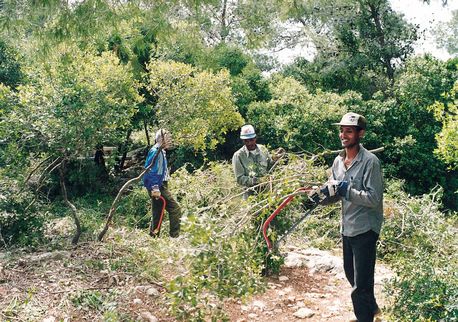
Immigrants employed in forestry work. KKL-JNF Photo Archive
Plantings in this period included some 250 small groves, mostly in wadis (or dry riverbeds), where surface runoff from winter rains collected. These small groves, known as limans, were planted at roadsides south of Beersheba. The Arava roads were also flanked by trees, their trunks and foliage adding new features to the monotonous landscape, and rest spots were created for travelers. More importantly, however, these windbreaks guarded against soil erosion in adjacent farm fields.
Southern afforestation also revived the role of the eucalyptus. In February 1983, headlines announced that eucalyptus trees, used in the draining of swamps at the turn of the century, were thriving in the Arava salt plains, especially around Ein Yahav and Yotvata. "The trees are developing nicely," was all KKL-JNF workers could say as they beheld the small oases that had emerged thanks to the leafy "new immigrants" from Australia. The trees again showed that they could acclimate in Israeli soil and help protect it. And KKL-JNF again showed that it could solve a problem of nature by utilizing nature itself.
Though plantings moved southward during this decade, KKL-JNF forestry workers continued to crown Jerusalem in a green belt, increasingly surrounding the capital. Every tree planted joined the band of green that already numbered more than a million trees, up and down hills. At Sataf, a nearby ancient village, an old spring was uncovered and a new aqueduct excavated, reviving the practice of ancient terrace agriculture. In a special project called bustanof (a combination of the Hebrew words for fruit garden and landscape), KKL-JNF rented Jerusalemites small patches to till at their leisure, enhancing the life of the hills and the zest for life of the residents.
In 1985, when the United Nations declared the Year of the Forests, KKL-JNF marked its 80th afforestation anniversary. Although plantings in the land had begun before 1920, dating back to the Bilu pioneers in the 19th century, this year marked the start of modern forestry in Israel. By dedicating a year to forests, which cover a third of the earth's surface, attention was focused on the importance of the local ones, which suffered not only from water and air pollution, but from fire, uncontrolled grazing, and development and infrastructure work. The emphasis in those years was consequently not only on planting, but on numerous research studies conducted with the assistance of KKL-JNF's Ecology Fund.
Work in the field continued virtually everywhere. The music of hoers digging tree wells and of children and adults planting saplings could not be stopped and, one after another, more and more forests were added, each yet another green spot on the land and a fitting, lasting commemoration for people and events.
In the summer of 1986, KKL-JNF dedicated a forest to the 37 paratroopers from Erez Israel who had parachuted into enemy territory in Nazi Europe during World War II. Located in Jerusalem's Neveh Yaacov neighborhood, it was inaugurated in the presence of IDF paratroopers, veterans of the wartime parachute operation, and relatives of those who had been captured and killed, such as Hannah Szenes and Enzo Sereni.
At Yatir, a Moroccan Jewry Forest was dedicated at a festive ceremony. French actor and singer Yves Montand planted a tree at Roglit in the Adullam region, near the memorial to French Jewry's Holocaust victims, and another tree – in memory of his wife, actress Simon Signoret.
KKL-JNF's newsletter from those days was filled with photographs of statesmen and celebrities, literary figures, and prominent personages who planted trees on visits to Israel. Other photographs show the unveiling of plaques for forests named after heads of state, leading personalities or, alternatively, Jewish communities wiped off the map during World War II.
In 1983, Yehiel Leket, Chairman of the World Zionist Labor Federation, joined KKL-JNF's Board of Directors and, two years later, after familiarizing himself with the Fund's work, he defined its time-honored tasks as follows: "Keren Kayemeth LeIsrael has the advantage over other Zionist funds in its folk character and the fact that it deals in education. The bond to the homeland soil is tangible and enduring, and the nurturing of this bond - a key mission undertaken by Keren Kayemeth, which is why it must foster relations with local and overseas schools." Leket added that "with respect to the Zionist Movement, Keren Kayemeth LeIsrael may be seen as a 'nature reserve,' untouched by a good deal of the movement's problems and shortcomings." This "nature reserve," like every oasis, had to be guarded and nourished.
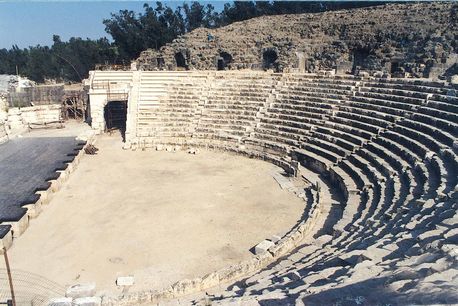
Archaeological excavations at Beit Shean. KKL-JNF Photo Archive
As part of its land reclamation work, KKL-JNF also helped excavate archaeological sites. In Beit She'an, an ancient Roman city was unearthed; at Zippori, Beit Govrin, and Maresha, important historical remains were discovered and incorporated into expansive public parks. At Shuni Fortress at the southern Carmel, a command post of the pre-state Etzel underground, the Fund developed Jabotinsky Park, named for the Zionist Revisionist leader. Speaking at the park's dedication, KKL-JNF Deputy-Chairman Shlomo Ariav noted that KKL-JNF was a shared apolitical endeavor of the entire Jewish People. Jabotinsky Park was one of a series honoring pre-state leaders, such as President's Forest (for Israel's first President, Chaim Weizmann), Ben Gurion Forest, Sharett Park, Eshkol Park, and Golda Park.
At the end of the 1980s, following several years of drought, KKL-JNF's Board of Directors under Moshe Rivlin decided to allocate considerable funds for water conservation and storage by building dams and excavating reservoirs. Some of the reservoirs served additional purposes, not only boosting irrigation supplies but doubling as fishing and recreation sites.
In 1987, the Hadassah-Eshet dam, one of the first, was constructed at Nahal Hayun in the Arava, mainly to collect rainwaters to enrich the aquifer as millions of cubic meters of floodwaters flow down from the Negev Plateau. At Kibbutz Sde Boker, the water captured by a dam irrigates nearby orchards and grazing lands. In the Lachish region, near Kedma, a large reservoir was built to utilize recycled effluents from the town of Kiryat Malachi to irrigate field crops, and additional reservoirs were constructed in the Beit She'an Valley and on the Golan. By the end of the decade, the Reshafim and Shifa reservoirs were collecting another three million cu. m. of water each year.
With some 100 reservoirs in the planning or construction stage, Fund old-timers noted that in the 1920s, 1930s and, later in the 1950s, KKL-JNF had had to drain stagnant water where damaging marshes had developed. Now, it was going out of its way to capture and conserve water – to make it stand still – not in swamps, of course, but in reservoirs, and not only in the baked, arid Negev, but all over the country. In their eyes this epitomized the Fund's vital role in meeting changing state needs, even if sometimes this meant drying wetlands and, at other times, "wetting" dry lands.
The main thing in all of its tasks was the soil, and KKL-JNF knew exactly how to care for it. In the swamp era, water had been a source of disease. Now, it was the elixir of life for both the soil and those who kept it, just one more aspect of care, alongside reclamation and afforestation; one of the three colors in KKL-JNF's brown-green-blue palette with which it painted and crafted the vistas of Israel. To this painting, every year KKL-JNF added more blue, its involvement in water supply dating back to water towers and Negev pipelines.
To spur on development, KKL-JNF also took an active interest in tourism projects. In the Negev, together with other agencies, it established the Ramon Crater Geological Park. It restored the historical outpost at Kibbutz Revivim and developed Golda Park, named for Prime Minister Golda Meir. Another park and nearby reservoir were established in the Arava and named after Pinhas Sapir, Minister of Finance in the 1960s and 1970s.
In the north, it established Jordan Park along the river, and planted Swiss Forest in the basalt earth above Tiberias.
In Jerusalem's south, it created an urban park around the Roman ruins of Ein Yahel. The wide-ranging park, in Nahal Refa'im between the neighborhoods of Gilo and Kiryat HaYovel, is another segment of Jerusalem's green crown which winds its way through the capital offering residents easy access to forest recreation.
The added value of all the parks, forests, and recreation areas was both scenic and environmental. Their main goal, however, was and remains to make life livable on the land and permit a living from the land, to steady our foothold and anchor our roots.
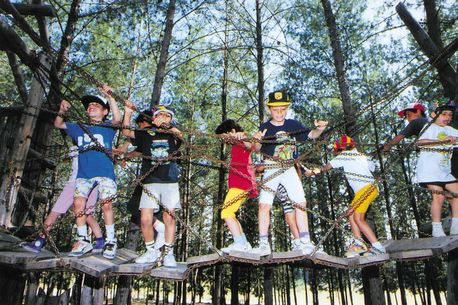
Photo: KKL-JNF Photo Archive
During these years of expanding and flourishing forestry, KKL-JNF found itself not only planning and tending woodlands, but also protecting them from fire – including from arson motivated by anti-Israel elements. The first Intifada left its mark not only in areas where Jewish and Arab communities stood side by side but on innocent forests that were among the sorriest victims. In its war against the flames, KKL-JNF set up an extensive, fire-fighting outfit, including all-terrain fire engines and 40 watchtowers countrywide.
Worst of all was the huge forest fire of 1989. For three whole days the Carmel was ablaze with flames consuming tens of thousands of dunams, among them the slopes known as "Little Switzerland." Another 1,200 fires broke out that "hot summer," more than twice the annual average, devouring 10,000 dunams of planted forest and 40,000 dunams of natural woodlands.
In response to the plague of forest fires of the summer of 1988, KKL-JNF had launched a large-scale publicity campaign to plant "A tree for a tree," rallying Israelis and Jewish communities abroad to raise funds for three and a half million new trees. Now, the Carmel fire prompted a telethon, with numerous people responding to "stamp out the black mark" that charred the ridges and "restore the green plumage" as Israeli entertainers called for both green trees and greenbacks...
Contributions poured in, large, small and… touching. An eight year-old boy, who had just won the lottery, contributed two hundred trees. Actor Ze'ev Revah, who had played the role of Salah Shabbati in the 1960 film by the same name, donated 100 trees. He recalled that he, too, had planted trees as a new immigrant in the Shaar HaAliyah transit camp, the same camp that was the first Israeli home to satirist Ephrai'm Kishon, the author of "Salah Shabati. "We have only one country," Revah said, "and it needs shade."
That same year, KKL-JNF's Plant-a-Tree Department hosted American actor Gregory Peck and singer Julio Iglesias, both of whom planted trees in the Jerusalem Peace Forest as a symbol of new hope for peace and prosperity.
Forestry workers toiled to clear inflammable material from the forest floor and install fire breaks and access roads so that fire-fighters might speed to the focus of a fire to prevent its spread.
Although forests now covered more than a million dunams of land, the Fund's afforestation people pointed out that they were still small, few, and far between compared to other countries, and not a single one could be allowed to burn down. Losing a forest, they said, was like losing a loved one, especially if one had seen it planted and nurtured from barren hillside to green slope. "Foresters, too, weep," one of the newspapers remarked.
At the end of the 1980s, the planting season was devoted to restoring forests damaged by or lost to fire. Some of the veteran forests that had burned down regenerated on their own from Aleppo pine seeds. Foresters, however, took the opportunity to diversify by planting also other forms of pine, resistant to the Matsucocus josephi, a pernicious scale insect, which had decimated trees at Shaar HaGai on the road to Jerusalem.
To help restore the forests and, at the same time, solve a problem unrelated to trees – unemployment – KKL-JNF's Director General at the time, Ori Orr, instituted the temporary employment of newly demobilized soldiers in forestry work. In 1988, some 300 people responded to ads, joining regular workers in pruning and other tasks, in fire prevention, fire-spotting and, when necessary, fire-fighting. KKL-JNF's re-enlistment in state needs, this time out of a transient economic difficulty, was again an investment in the future. A year later, in 1989, there were still many fires, mostly the work of arson, but the extent of the damage was now much more contained thanks to alertness, deployment and additional manpower.
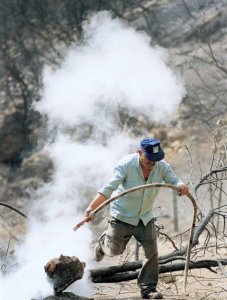
Forest fires. KKL-JNF Photo Archive
Meanwhile, KKL-JNF was summoned back to a site it had worked at 70 years earlier, the Jezreel Valley. This time it was not to redeem the land from the hands of others, but to rescue it from nature. Valley land had become salinized; the country's breadbasket, the Fund's major achievement, was in danger of turning into a salt marsh. Hundreds of dunams were affected. At some spots, bogs sprouted reeds, reminiscent of the days of the Third Aliya immigration wave.
The dimensions of the problem soon defined it as national project, and KKL-JNF put its shoulder to the grindstone. The goal was to lower the water table and drain extensive areas. The Kishon riverbed was deepened along certain segments and its meanders made straighter. The bulldozers now at work were a far cry from the equipment used to reclaim the soil and drain the swamps in the 1920s, nor were the workers the same, of course. But it was the same KKL-JNF returning to the Valley for the same reason: to save the soil and permit life on, and from, it.
Towards the end of the decade, the state again found itself absorbing a large wave of immigrants, from both the former Soviet Union and Ethiopia (the latter in Operation Moses); a population increase of almost a million people. KKL-JNF's policy statement issued in the summer of 1990 described the immigration as the triumph of Zionism and of the Fund's vision because absorption demanded the availability and utilization of national land. World Chairman Mosh Rivlin said: "As we deal with the land, it should be remembered that rapid solutions are possible only because the State of Israel has upheld Keren Kayemeth's vision of national ownership over land. This means that today land can be released in Galilee, the Negev, and elsewhere in the service [of absorption]." KKL-JNF, in fact, "jumped right in," preparing infrastructure for immigrant housing all over the country, from Carmiel in the north to Eilat in the south.
The bulldozers were on the move once more, preparing land for new neighborhoods. The Fund in 1990 and 1991 earmarked 40% of its budget for the task and, in a two-year period, prepared the infrastructure for 60,000 housing units at dozens of locations. In Eilat alone, infrastructure was prepared for some thousand housing units, followed shortly by another thousand.
But KKL-JNF understood that housing was not enough. Development works aimed to create income sources for both new and veteran Israelis in various parts of the country. To this end, KKL-JNF continued to build roads and reclaim land not only for housing, but also for tourism sites that would create hundreds of jobs. In Mitzpe Ramon, where a lot of apartments stood empty for lack of employment opportunity, it built and extended roads to make the town more accessible and worked on such projects as the Hai-Ramon Wildlife Park, the Environmental Sculpture Garden, the Crater Promenade, and hiking trails in the Ramon Crater.
At the same time, it was busy fashioning a recreation site at Ganei Huga in the Beit She'an Valley, and precedence was given to both Galilee and the Negev. The Fund began work on enlarging the lake and park at Yeruham, and on planning and developing the Ein Gedi shoreline at the Dead Sea and beaches along the Sea of Galilee.
In 1990, KKL-JNF hosted new immigrant youngsters at its summer camps. For many, this was their first encounter with Israeli-born youth, an important chapter in both their social absorption and direct contact with the homeland soil. Towards the end of 1990 a world conference of KKL-JNF leaders from 26 countries convened in Jerusalem, to lend support to the enormous endeavor of immigrant absorption. They pledged to raise $100 million within three years.
Almost all of the tasks in which the Fund was involved at its 90th anniversary continued to preoccupy it en route to its centennial.